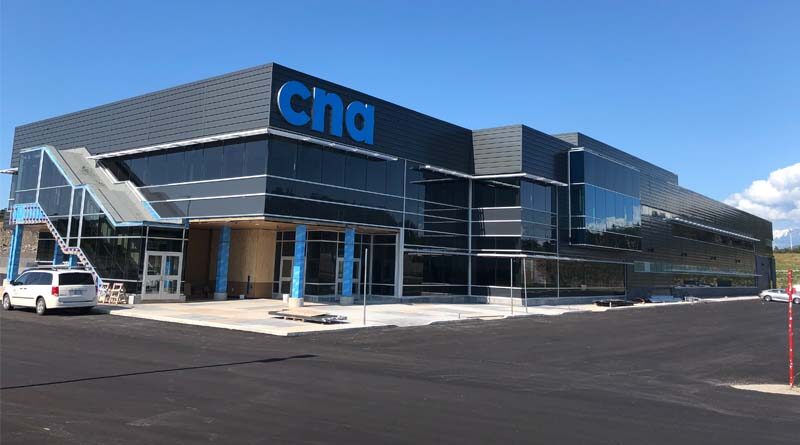Five Tips to Designing a Modern Industrial Learning Center
It’s possible to give industrial students an innovative educational experience while designing for different learning styles
By Paula Pittman
I love working on projects for education clients. There’s just something rewarding about designing a building that aids in someone’s career development and personal growth. How can I help students perform their best? How can I design for different learning styles?
These are the kinds of questions that my team and I asked while working on the new Heavy Equipment Centre of Excellence, a project at the Bay St. George campus for the College of the North Atlantic (CNA) in Stephenville, Newfoundland. The project serves students in the Heavy Equipment Industrial Trades programs, such as mobile crane operator, heavy equipment operator, and commercial driver/class 3 driver. It is a two-floor facility that features classrooms, a carpentry shop, workshops for high bay maintenance and heavy equipment, a lunchroom, and administration offices.
Why am I proud of this project? Well, I’m proud that this building reflects the distinct traits of an innovative, modern, industrial learning space. Schools for industrial programs have traditionally felt dark, dank, and cramped. Those buildings, many built a half-century ago, often didn’t have bright classrooms or gathering spaces where students could connect. I imagine that some students found it hard to focus in older industrial learning spaces, especially if those students were surrounded by sounds and smells from the heavy equipment work.
Learning environments are evolving, and as designers, we try to create spaces for different learning styles. Perhaps one student learns best through visual cues, while their seatmate gathers more through verbal or physical learning. It’s important to keep all learning styles in mind.
Are you looking to create an elevated educational experience for your industrial learning space? Here are some ways to accomplish that.
-
Incorporate daylighting
Daylighting contributes to a healthy learning environment. Research has shown that daylighting can improve test scores. Access to natural light and outdoor views helps to support healthy circadian rhythms.
As I mentioned earlier, traditional industrial learning spaces often felt very dark. So, for the CNA’s Heavy Equipment Centre, we used glass and windows wherever we could. We added translucent glazing and clerestory windows in the two-story high bay workshop areas. Windows along the second-floor classroom corridor offer views into the bays and to access borrowed light in the bay itself. Students won’t feel like they’re in a dark warehouse. They’ll be working in a bright environment, and each classroom has expansive glazing to let natural light shine in.
-
Add modern classrooms
Older industrial learning facilities didn’t always include traditional classrooms. Students would have to learn in the workshops and discuss projects there.
But adding modern classroom settings can elevate the learning experience. This way, students can perform hands-on work in the industrial areas and bring the discussion back to a classroom. The CNA project offers teachers, students, and industry partners options for learning spaces.
-
Expose building components
Here’s an idea that might not feel obvious for your design: Consider exposing some of the building pieces. If you’re designing for industrial students, they’re likely interested in how and why building systems work. Instead of putting a ceiling over the inner workings of your building, create visual interest and embrace learning opportunities.
For the Heavy Equipment Centre, we’ve exposed building systems in many areas. We designed exposed ceilings down the corridors that show ductwork and cable trays. We used CNA’s colors—green for the cable trays, and blue for the cables—to match other parts of the building. There’s also a glass-backed elevator, so students can see the mechanics as the elevator travels up and down.
-
Create gathering spaces
When designing a modern education facility, it’s wise to provide as much flexibility as possible for various group sizes and collaboration styles. How can you incorporate different gathering spaces?
At the Heavy Equipment Centre, we designed alcoves with soft seating, where small groups can meet to enjoy lunch or work on a project. In the cafeteria, there are a variety of spaces so students can collaborate in smaller or larger groups, providing people a chance to interact away from classrooms.
-
Prioritize acoustics and air quality
Multiuse spaces like industrial learning facilities present unique challenges for proper acoustic and air quality control measures. The noisy shop spaces that produce fumes and smells must be properly treated so as not to create air quality or occupant comfort issues in the rest of the building.
On the CNA project, our mechanical and architectural designers worked closely together to deliver a facility where the different occupancies have nearly no impact on each other. We used acoustic panels on the walls between noisy process spaces and the remainder of the building. We sealed the classrooms for dust, smoke, and acoustics. That way, students and staff can focus on their work.
A Modern Industrial Learning Space
The Heavy Equipment Centre proves it’s possible to create a modern industrial learning space. I find these projects rewarding, and I’m thrilled that we’ve helped to create a building that instills pride in staff, students, and visiting industry professionals.
Stantec Principal and Senior Architect Paula Pittman has a focus on complex projects in the industrial, health and educational sectors.

